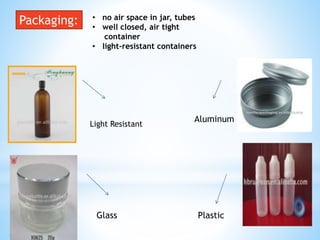ointment
- 2. OINTMENT
- 3. Presented By: ï§ TANJILA TABASSUM REG NO:12103078 ï§ MD.FAHIM SHAHRIAR REG NO:12103096 ï§ SADIA ANJUM REG NO: 12103101 ï§ JERIN RAHMAN REG NO:12103107 ï§ BADHAN SARKER REG NO: 12103114
- 4. CONTENTS: ï Its advantages and disadvantages ï Ideal properties of ointment ï Types of ointments ï Applications of ointment ï Ointment base type ï Manufacturing of ointment ï Evaluation parameters ï Ointment absorption through skin ï Packaging & Storage ï Available market preparations ï Special circumstance
- 5. * *Ointment is a topical medication applied on the body surfaces that is homogeneous, viscous, spreadable, semi-solid preparation with a high viscosity.
- 6. ADVANTAGES Handling of ointments is easier than bulky liquid dosage forms. They are chemically more stable than liquid dosage forms. Convenient and easy to apply.Chance of side effect is reduced. Avoidance of first pass metabolism..
- 7. DISADVANTAGES They are bulkier than solid dosage forms They are less stable than solid dosage forms. The base which is used can be oxidized Time consuming. May be messy or uncomfortable
- 8. Characteristi cs of an Ideal Ointment chemically and physically stable. smooth and free from grittiness melt or soften at body temperature and be easily applied. non-irritant and should have no therapeutic action finely divided and uniformly distributed throughout the base
- 10. MEDICATED OINTMENTS Dermatologic ointments Ophthalmic ointments Rectal ointments Vaginal ointments Nasal ointments
- 13. There are various problems when an ointment is suggested for treatment such as: Burns Cuts boils and scars Itching skin problems like eczema, dermatitis and psoriasis.
- 14. Types of Ointments Bases Hydrocarbon bases
- 15. Absorption base Types of Ointments Bases
- 16. Types of Ointments Bases Emulsifying bases Water soluble
- 17. MANUFACTURING OF OINTMENT: The three variables in the manufacturing of ointment are ï· Time ï· Temperature and ï· Mechanical work
- 18. Incorporation Method MANUFACTURING OF OINTMENT In this method the components are mixed until a uniform preparation is attained, a stainless steel ointment spatula is used for this method
- 20. MANUFACTURING OF OINTMENT Fusion Method A fusion process is done only when the components are stable at fusion temperatures. Ointments containing white wax, yellow wax, paraffin and high - molecular - weight PEGs are generally prepared by the fusion process.
- 21. 1.Penetration of the base through the skin 2. Absorption of the drug into the blood Stream 3. Rate of release of the drug from the base
- 22. Process of ointment absorption through skin involves:
- 23. Microbial Content: STAPHYLOCOCCUS AUREUS PSEUDOMONAS AERUGINOSA AMONG THE ANTIMICROBIAL PRESERVATIVES USED TO INHIBIT MICROBIAL GROWTH IN TOPICAL PREPARATIONS ARE: benzoicacidPhenol propyle paraben Methyl paraben
- 24. Packaging: âĒ no air space in jar, tubes âĒ well closed, air tight container âĒ light-resistant containers Glass Plastic Light Resistant Aluminum
- 25. âĒ Cool place to avoid softening and liquification of base Storage: âĒ 36 month, 48 month and 60 months âĒ the month during the batch was certified and 6 months from date of opening Expire Date: âĒ FOR EXTERNAL USE ONLY âĒ STORE IN A COOL AND DRY PLACEâ Labeling
- 27. Newborn babies Pregnancy and lactation: Ditranol Salicylic acid ointment Special circumstances:
- 28. ï www.albania.com ï Wikipedia ï The Theory and Practice of Industrial Pharmacy- Leon Lachmann, Hebert A, Liuberman, Joseph L. Kanig ï Pharmaceutics: The Science of Dosage Form Design- Michael Aulton ï Dispensing for Pharmaceutical Students- Cooper and Gunn






























